11 Living with Water
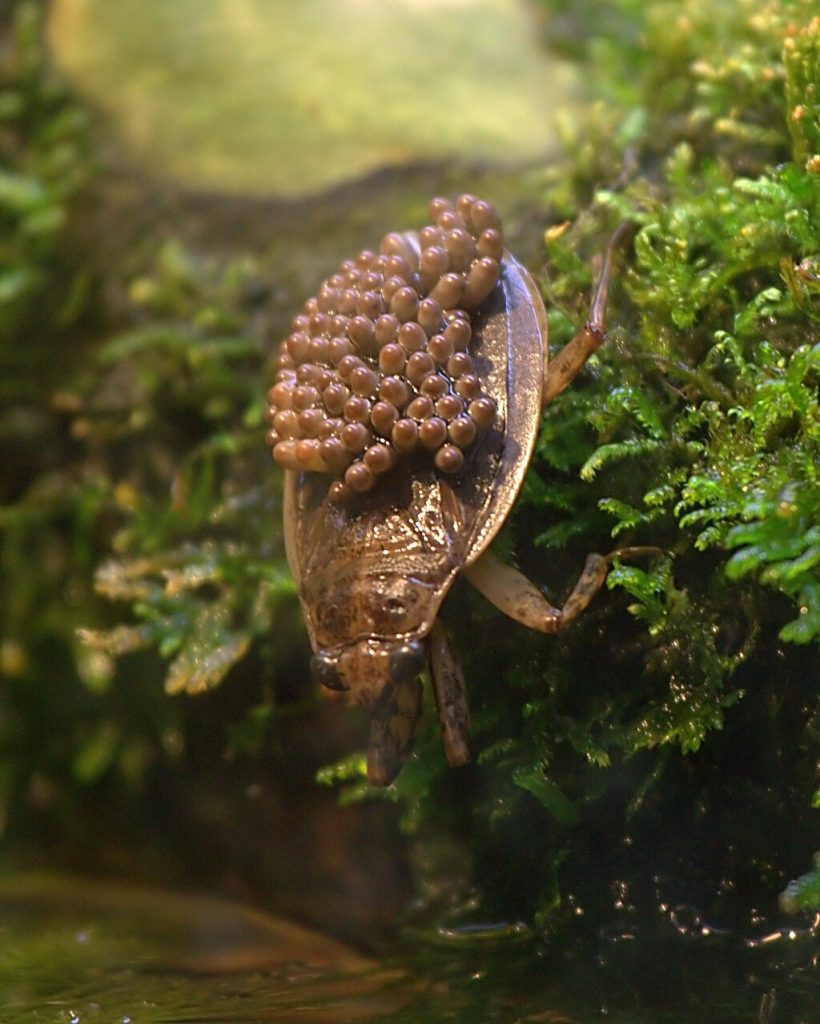
In this chapter we will take a look at insects that have returned to water. The topics we have covered so far feature adaptations to the life on land: aquatic insects had to re-adapt their forebearers’ terrestrial adaptations to a water-dwelling lifestyle. We examine the unique problems faced by insects in the aquatic environment; the prime challenge being able to breathe when their respiratory system was pre-adapted to a terrestrial habitat.
Learning Objectives
- Be aware of the adaptations that aquatic insects have evolved to allow them to breathe underwater
- Recognise that the aquatic lifestyle may have evolved from a terrestrial lifestyle in insects
Return to Water
Most insects are terrestrial; however, some, over evolutionary time, have gone back to the water either as immatures or as adults. All insects that have a juvenile aquatic stage appear to have adapted to water secondarily from terrestrial ancestors. Consequently, the respiratory system of aquatic insects is derived from that of their terrestrial cousins. Refer back to the chapter on Insect Cuticle for a description of the terrestrial insects’ tracheal system.
| Common name (Order) | Life stage |
|---|---|
| Dragonflies & damselflies (Odonota) | juvenile |
| Stoneflies (Plecoptera) | juvenile |
| Caddisflies (Trichoptera) | juvenile |
| Alderflies, dobsonflies (Megaloptera) | juvenile |
| Mayflies (Ephemeroptera) | juvenile |
| Water bugs, water boatmen (Hemiptera) | juvenile & adult |
| Diving Beetles, whirligig beetles (Coleoptera) | juvenile & adult |
| Mosquitoes, midges, rat-tailed maggots (Diptera) | juvenile |
Note: Aquatic nymphs of Ephemeroptera, Odonata and Plecoptera are often called naiads.
Breathing Under Water
Possession of an aquatic life stage places demands on the terrestrial body form, in particular the ability to breathe underwater. Insects achieve respiration underwater using multiple methods. First, by surface breathing. The prime example is where hydrophobic hairs allow access to air at the water surface; for example, the siphons on abdomen of a mosquito larvae has hydrophobic hairs that open out when the surface tension is breached, allowing the respiratory system to directly access the atmosphere.
A number of insects (and spiders) are bubble carriers: they drag an air bubble with them as they dive below the surface. The air bubble overlies the spiracles so the normal terrestrial breathing pattern can continue underwater. Some adult beetles use this approach. The bubble may be held under the elytra. The bubble can exchange oxygen and carbon dioxide with the water due to the diffusion gradient generated by the insect. In this case the bubble acts as a “physical gill”. However, the bubble tends to shrink in size over time so it must be replenished by regular visits to the surface.
Some aquatic insects such as the water boatmen (Hemiptera) are carriers of a thin film of air, termed a plastron. Hydrophobic hairs trap a film of air against the body. The plastron acts as a physical gill—just like an air bubble—but it does not need the regular replenishment required of air bubbles. The reason is that the volume of the air layer is kept constant by the entrapping hairs, meaning that the diffusion of gases continues indefinitely.
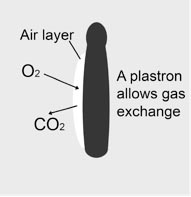
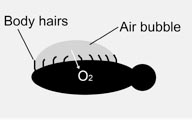
These physical gills allow exchange of oxygen and carbon dioxide with the water. Oxygen, comprising 20% of the atmosphere) is water soluble, as is carbon dioxide. Nitrogen is relatively insoluble in water.
Other insects cope with water by possessing a closed tracheal system with no spiracles that would allow entry of water into the tracheal system. They maintain an air-filled tracheal system without any direct access to the external atmosphere. They utilise cutaneous respiration that allows diffusion of gases across the cuticle. Obviously, the cuticle must be thin and permeable.
Tracheal gills such as those found in damselfly naiads are a further specialisation of the closed tracheal system. Portions of body wall (often outgrowths) that are very rich in trachea are the sites where gas exchange occurs. The cuticle is extremely thin, allowing oxygen to diffuse from the water to the trachea within the gills. While vertebrates utilise haemoglobin to store oxygen in solution, this approach is rare in insects. Only one group, some chironomids (midges, order Diptera) possess haemoglobin the the haemolymph to store and release oxygen in the body. It is believed they have this capability because they frequent water that is rich in decaying organic matter, which is frequently anaerobic in nature.
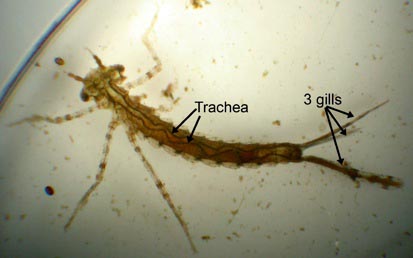
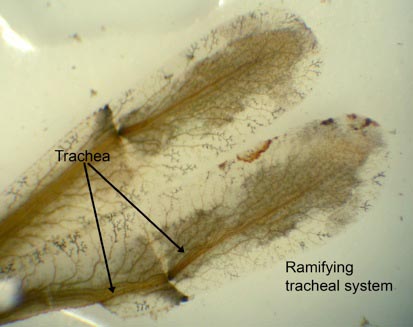

Examples of methods used to breathe underwater
- Water boatmen (Order Hemiptera, Family Corixidae) use a plastron to breath underwater. Cuticular hairs on the body wall capture a thin layer of air. The plastron allows oxygen and carbon dioxide to diffuse according to their concentration gradients.
- Water beetles (Order Coleoptera) hold a bubble of air on the body with hairs or under the elytra. The air bubble is replenished when the insect moves to the surface. Insects that use and deplete a bubble of air need to regularly move to the surface to replenish.
- Damselfly nymphs have leaf-like appendages at the end of the abdomen; they are closed gills. These work because they have thin cuticle and a bed of ramifying trachea which collect air across the thin cuticle and feed it back into the main airways of the body.
- Chironomids (Diptera: Chironomidae) are usually the most abundant group of stream macroinvertebrates both in numbers of species and as individuals, in freshwater aquatic habitats. As adults, they are delicate mosquito-like flies and are grub-like as a larva. Often they are called bloodworms because they can have bright red haemoglobin in the body to take up and store oxygen; beneficial in sludgy environments low in oxygen.
Reproduction in Aquatic Insects
Eggs can be embedded in a jelly-like, hygroscopic matrix produced by the female. In other groups, eggs can be glued to the substrata such as a plant or rock, to prevent them being washed away.
They can be inserted into plants either stems near the surface or into algal mats. They can be broadcast on the water surface, either singly or in clusters. Some eggs are sticky and attach to plants or other objects in the environment either singly or in clusters. Mosquitoes deposit eggs in floating rafts.
Water bugs (Belostomatidae) oviposit eggs onto the male’s back and the male carries the eggs until they hatch (see image at the beginning of this chapter!)
Activities
Activity 11.1:
Go to this website and read the pages on the water strider, the dragonflies (Odonata), and the water beetles (Coleoptera: Dytiscidae) and gather reasons why these groups may or may not be useful for monitoring water quality.
Activity 11.2: Ever wondered how water striders float? Check this out this video (YouTube, 3m 33s)!
Activity 11.3: Watch this video on aquatic beetles. (YouTube, 3m 06s).
Topic Review
Do you know…?
- the ways that insects cope with gas exchange in the aquatic environment
- the attributes of freshwater insects that make them useful for monitoring water quality.

